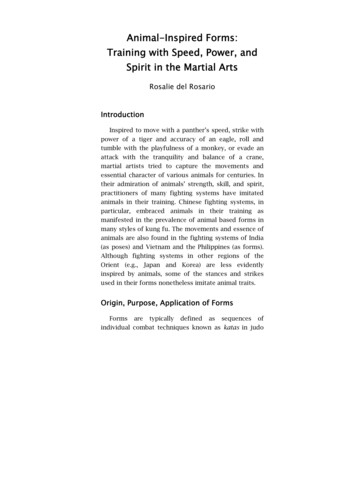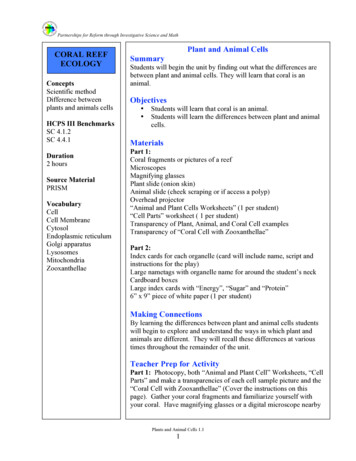
Transcription
Animal-Inspired Forms:Training with Speed, Power, andSpirit in the Martial ArtsRosalie del RosarioIntroductionInspired to move with a panther’s speed, strike withpower of a tiger and accuracy of an eagle, roll andtumble with the playfulness of a monkey, or evade anattack with the tranquility and balance of a crane,martial artists tried to capture the movements andessential character of various animals for centuries. Intheir admiration of animals’ strength, skill, and spirit,practitioners of many fighting systems have imitatedanimals in their training. Chinese fighting systems, inparticular, embraced animals in their training asmanifested in the prevalence of animal based forms inmany styles of kung fu. The movements and essence ofanimals are also found in the fighting systems of India(as poses) and Vietnam and the Philippines (as forms).Although fighting systems in other regions of theOrient (e.g., Japan and Korea) are less evidentlyinspired by animals, some of the stances and strikesused in their forms nonetheless imitate animal traits.Origin, Purpose, Application of FormsForms are typically defined as sequences ofindividual combat techniques known as katas in judo
Animal-Inspired Formsand karate, poomse in taekwondo, taolu in wushu, andjunanahon in aikido. They are an integral part oftraining in most martial arts, laying the foundation forbasic techniques used in sparring and combatsituations. Among many explanations to the purpose offorms in training a generally accepted one is todemonstrate the offensive (e.g., hand strikes, kicks) anddefensive techniques (e.g., blocks, throws, stances,footwork), as well as balance, strength, flexibility,coordination, and targeting1.From thorough research on the origin, purpose, andapplication of kata (or more generally, forms), jujitsuhistorian Donn Draeger considers learning andpracticing forms a “normal process of ‘walking beforerunning’ in which efficient movements and techniquewere first designed, tested, improved, and finallystandardized through the media of kata”2. Heconcludes that fighting systems were constructed byconsolidation of pre-existing forms and fightingtechniques.Animal-inspired FormsForming the basis of many fighting styles, forms inmost Chinese fighting systems have been derived fromthose animal movements and behaviors that wereconsidered responsible for an animal’s efficient fightingtactics. In many Asian cultures, animals are thought topossess natural and sometimes supernatural powers,talents, and skills, which they use for fighting. Martialartists were inspired by the aggressive or defensivetemperament of animals that allowed them to survivein harsh physical environments, amidst predators and2
Rosalie del Rosariocompetitors. It was therefore reasoned that the bestway to fight effectively was by imitating animals.3The history of many fighting systems is not welldocumented. Stories on how animal-based formsoriginated are consequently often anecdotal, beingpassed down orally from master to student. tioners to develop these forms are largelyundocumented, many interpretations of the origins ofanimal-inspired forms are inconsistent and sometimesbiologically inaccurate. For example, inspiration for thepraying mantis form supposedly came fromobservations of a cicada and praying mantis engaged ina “death match.” However, cicadas in real life do noteat other animals but instead feed on plant roots. Thecicada’s participation in the “death match” with themantis is hence limited to playing the role of desperateprey rather than a threatening predator.While the animal being imitated often gives thename to the technique being performed, it is unclearhow some of the forms received their animal-basednames. Techniques in the form may be named after ananimal because they were developed by a practitioner’sobservation of that animal’s movements, or because thepractitioner resembled the animal while performing thetechniques. In either case, animal movements havebeen imitated in many martial art forms.Some forms are based on only the movements of ananimal (e.g., praying mantis and eagle claw styles); inother forms both movement and behavior of an animalare mimicked (e.g., monkey style). In some forms notonly is movement imitated, but also the animal’s spiritis cultivated and exhibited (e.g., snake, crane). The3
Animal-Inspired Formssnake form, for example, develops internal energy,while the crane style exhibits stability and tranquility,manifested by the ability to stand on one leg withoutshifting weight.4 Often fighting systems combinemovements and traits from different animals.Many Chinese fighting systems originated at theShaolin Temple5, situated on the foothills of SongshanMountain in Henan province of China. The grasslandsand forests near the Shaolin Temple were home tomany animals known to have inspired martial artforms, such as praying mantis, tigers, white cranes,monkeys, snakes, and panthers. The admired traits ofthese animals are commonly applied in forms, knownby their namesake as strikes (e.g., crane’s beak andeagle’s claw), blocks and parries (e.g., praying mantis),stances (e.g., crane stance), and footwork (e.g., monkeysteps). The following set of figures show severalcommon Shaolin hand forms named after animal traitsand widely used in many of the Asian martial arts.6Figure 1: Dragon Claw (two styles)Figure 2: Elephant Fist and Elephant Head Hand4
Rosalie del RosarioFigure 3: Panther Fist (palm and profile views)Figure 4: Snake Hand (palm and profile views)Figure 5: Crane Hand (left) and Tiger Hand (right)Animal-inspired forms were also created andpracticed in Indian, Vietnamese, and Filipino fightingsystems. In regions where fighting systems were notdirectly inspired by animals, such as in Japan andKorea, techniques that imitate animals are neverthelessincluded in their respective fighting systems. Manytaekwondo forms use animal-derived techniques, suchas horse, cat and tiger stances, or snake hand, ox jawand tiger mouth strikes.5
Animal-Inspired FormsChinese Fighting SystemsLaying the foundation of Shaolin martial arts is thefive animal system, based on dragon, tiger, panther,snake, and crane. This system is integral to the Shaolinfighting styles and has influenced many other kung fustyles as well. The five animals represent physical andspiritual traits that are needed for fighting skills to beeffective. Shaolin practitioners believed that imitationof the traits of these five animals would contribute todevelopment of inner strength and physical power.7Figure 6: Dragon form6
Rosalie del RosarioA mythological beast, the dragon, is ranked highestin the hierarchy of animals, with supernatural powersand swift and nimble movements. Yang (1996)summarizes the key traits of each form: The dragonform trains the spirit, exhibiting the ability to focusintent and develop qi. The tiger is known for itsstrength, its form trains the bones, developing speedand strength. The panther (or leopard) form focuses oncultivating power and speed, while the snake formemphasizes the development of qi. The crane, believedto live long, nurtures life-essence. Its form captures thecrane’s ability to conserve and protect the essence ofthe body. The five animal form combines the animals’strength and spirit, establishing internal and externalmovements of hard and soft techniques.8 Executingtechniques in these forms allows one to exhibitoutward characteristics of the animals such as dragonpalm or tiger claw, as well as their inner essence, suchas leopard’s speed and crane’s elegance.9Similarly, one of the supposed origins of tai chichuan was from observation of the interaction betweena bird and a snake. Taoist priest, Jang San Feng,observed that the bird’s movements were “sometimessoft, sometimes hard but always quick.” These relaxedmovements were more in line with his Taoist beliefsthan many of the fighting systems that he believedused too much strength and heavy breathing. Hedeveloped a system, tai chi chuan, which involvesmovements that are both soft and hard, both powerfuland performed with light relaxed breathing.10Likewise, other kung fu forms also imitate animalmovements, behavior, and spirit. Among the mostpopular modern styles are the praying mantis and eagle7
Animal-Inspired Formsclaw style, monkey style and crane style.Praying Mantis StyleThe praying mantis system is thought to have beendeveloped by Wong Long, a Shaolin monk, who wasinspired by the ability of the predaceous insect toovercome the larger and stronger cicada. Typically, amantis lures a cicada into striking range and thenquickly reaches out with its elongated front legs to grabthe hapless prey. Although the original praying mantissystem has branched into several styles, they aredistinct in imitation of the insect’s quick and aggressivefighting tactics, and all include a constantly movingfighting style that calls for changing direction andangle of attack to break the enemy’s guard.11Figure 7: Praying Mantis formThe praying mantis system is based on twofundamental principles: the ability to grab theopponent quickly like the mantis (mantis claw), andagile and balanced footwork (monkey steps) patternedafter that of monkeys.12 The grab was originally done byimitating a praying mantis’ front claw, “with the indexfinger extended forward, supported by the thumb, andthe other fingers bent back toward the palm,”13 and isused both offensively (e.g., to strike, grab or pull) and8
Rosalie del Rosariodefensively (e.g., in blocks). In lieu of the difficulty ofimitating the six-legged footwork of insects, the prayingmantis system primarily uses jumping and turningfootwork, with strong stances that are patterned afterthe agile and balanced movements of monkeys tochange the angle of attack and close in on an opponent.Eagle Claw SystemFigure 8: Eagle formDifferent from many other fighting systems, thepurpose of the eagle claw system is not to kill or maim,but to control and temporarily disable the attacker.This system is based on the eagle’s cleverness, speed,and strength to trap and hold its prey with its sharptalons. Typically the claw hand (made by folding allfingers into half-clenched position) initially blocks theopponent’s attacks, then quickly controls and traps thearms and joints of the opponent into submission.Finally, a strike is dealt to a pressure point somewhereon the body.14 The kicks involved in this form alsocenter on locking techniques and foot traps. All tenforms in this system are empty-handed and can beapplied to disarm and disable a person.9
Animal-Inspired FormsMonkey StyleThe monkey style imitates the monkey’s speed,agility and playful behavior. Stories on how the monkeyform originated vary widely. One anecdote ascribes theform to a martial artist with a short temper, Kao Tse,who was imprisoned for killing a fellow villager duringa fight.15 While in prison, Kao Tse studied a group offierce monkeys that guarded the exit gates. Heobserved that each monkey had a different fightingstyle, and hence developed five different fightingpatterns based on these monkeys, one of which is thedrunken monkey style. While all monkey forms involveacrobatic tumbling and rolling, this particular drunkenmonkey form emphasizes acrobatics with low stancesgiving the appearance of drunkenness. The attacker,deceived into taking advantage of the seeminglydrunken monkey, is dodged by the monkey whocounterattacks with snap, spring, and thrust kicks orgrabbing, locking, and hooking hand work.Figure 9: Monkey form10
Rosalie del RosarioThe monkey style generally imitates the quick, lightsteps or short springy steps of monkey’s gait.16 Many ofthe monkey form techniques are done while lying orrolling on the ground.17White Crane FormUsing the crane’s sharp beak, powerful wings, andtranquil spirit, the white crane form combines bothhard and soft techniques, described by Yang (1996) as“moving the hands soft and reaching the target hard.”The crane style is often considered a completelydefensive system because the white crane, thought tobe a weak animal, never initiates the attack.Instead, a crane defends itself by dodging andevading an attacker using its ability to jump and fly.Counterattacks utilize the striking power of the wingsand accurate, jabbing attacks to vital areas with thedagger-like beak. The footwork of the crane relies onconstant evasive movement in low stances with circlingtechniques. The crane form exhibits tranquility andbalance, in imitation of the crane standing on one leg,with wings outstretched, balanced and preparing for anattack. Fists are held like beaks or feathered wing-tips,using one hand to strike and the other to maintainbalance or counterattack.Southeast Asian Fighting SystemsIn Vietnamese martial arts, there is a saying, “Enterlike the snake, withdraw like the tiger”.18 Like theChinese forms of the Shaolin monks, the ancientVietnamese fighting arts known as vovinam are alsobased on animal styles. Vovinam combines five distinct11
Animal-Inspired Formsanimal styles into one complete empty-hand fightingsystem.Figure 10:A Flying Scissors Kick in Vovinam19The animal forms in vovinam are taught insequence, beginning with tiger, then monkey, crane,panther, and finally snake. Direct movements of powerand strength characterize the tiger style. Panther stylede-emphasizes power in favor of quick mobility, usingmany flying kicks. Monkey style utilizes grappling andclose infighting techniques, while crane styleemphasizes long-reaching circular techniques thatinclude fast parries. Snake style, xa quyen, uses fast,deceptive movements emphasizing parries andcounters to strike at vital points. The primarytechnique of snake style is the spear hand, often usedto strike the eyes or throat. The snake style of vovinamis distinguished from the snake style of kung fu in thatthe former style is distinctly characterized by usingparries that twist and convert into darting strikes with12
Rosalie del Rosarioa spear hand. Front kicks to the groin and low sidekicks to the legs are the primary kicks in the snakestyle.Movements of the snake are also found in Filipinomartial arts, such as the Sayawan Apat form of kuntawlima-lima. Kuntaw is a fighting style in the Philippinesthat “uses the natural weapons of the body forblocking, striking, kicking, and throwing”.20 In theaforementioned form, the defender exhibits a snakestance accompanied by a knife-hand block to defendagainst a low snap kick.Kalarippayattu, an Indian Fighting SystemThe South Indian martial art, kalarippayattu, usesempty-handed techniques to attack, defend, joint lock,and throw opponents. Fundamental to “bodypreparation” in kalarippayattu are exercises thatinclude basic poses, vadivu, which are based on themovements and essence of animals. Learning the eightbasic poses of animals is a prerequisite to practicingempty-hand combat. The horse pose, asvavadivu,emphasizes the ability to “concentrate all powerscentrally” while jumping forward with a thrust (e.g.elbow strike). The peacock pose, mayuravadivu,demonstrates the ability to balance on one leg, witharms spread like wings, and shifting to the other legand attack by jumping and flying. The snake poseimitates a snake’s manner of attacking: quickly turningin any direction while standing on its tail firmly plantedon the ground. The cock pose develops the ability touse all parts of the body (e.g. wings, neck, legs,fingernails). The essence of the cock is captured in the13
Animal-Inspired Formsdescription of this pose: “He will lift one leg and shakehis feathers and neck, fix his gaze on the enemy, andattack”.21Techniques from Japanese Fighting SystemsAlthough forms in the Japanese martial arts are notnamed after animal movements, many hand techniquesthat use fingers as weapons are nevertheless namedafter animals. For example, keito, or chicken’s beak, ofOkinawan Shotokan karate, is a variation of theforefinger spear hand, and is similar to the hookinghand of praying mantis kung fu, though it is used in astabbing motion as opposed to being dropped down ontargets (e.g. collarbone) as done for the praying mantishooking hand. The middle finger fist, naka yubiipponken, of the chinte kata, uses the middle finger asthe striking weapon, as done for the phoenix-eye orelephant-nose fist of some Chinese fighting styles.22 Yetanother animal-derived technique is the “eagle’s beakhand” of gojushiho-dai kata, which is formed when allfive fingertips are pressed together to form a strikingsurface.ConclusionHumans have long admired the strength, skill, andspirit of animals that allows them to survive inchallenging environments. Martial artists naturallyemulated the more effective fighting tactics of animalsand incorporated these motions into the techniques oftheir fighting styles. The exact geographic origins andhistory of the forms that embrace the qualities of the14
Rosalie del Rosarioanimals are often undocumented and controversial.Still, many of the Asian fighting systems haveincorporated aspects of animal movements andessence. This is manifested by the prevalence ofanimal-inspired forms in many of the martial arts.Chinese fighting systems, in particular, have embracedanimal movements and spirit in their training as seenin many of the forms named after animals. TheSoutheast Asian martial arts of India, Vietnam, and thePhilippines have also incorporated animal movementsin their poses and forms. And to a lesser extent, animaltraits have found their way into Japanese and Koreanmartial arts as strikes and stances in some of theirforms.15
Animal-Inspired FormsReferencesDowd, Stephen K. “Showing the Forms of Filipino KuntawLima-Lima.” Journal of Asian Martial Arts, 1997. v. 6, #2,pp. 70-79.Dragger, Donn F. “Judo Randori No Kata and Ju No Kata. Part1: Nage No Kata and Katame No Kata,” an article in theAAU-JBBF Judo Handbook, edited by Donald Pohl, AmateurAthletic Union of the United States, New York, N.Y, 1966,(out of print). The entire article is available online d July 22, 2004.Hallander, Jane. The Complete Guide to Kung Fu FightingStyles, Burbank, CA: Unique Publications, 1985,ASIN# 0865680655.Hallander, Jane. “Kung-Fu Fighting: The Intricate PrayingMantis Style.” Black Belt Magazine, January, 1986.Hung, Lai and Brian Klingborg. The Secrets of NorthernShaolin Kung-Fu: The History, Form, and Function of Pek SilLum. Tokyo, Japan: Tuttle Martial Arts, 1999,ISBN# 0804831645.Lowry, Dave. “The Karate Way: The Finger Weapons ofKarate.” Black Belt Magazine, April, 1992.Although Black Belt Magazine seems to have removed allarchival articles from their website, the full text of thisarticle has been archived by Google athttp://tinyurl.com/53lel; accessed July 22, 2004.Ting, Leung. Drunken Monkey Kung Fu. Hong Kong:LeungTing Company, 1988.BAFA reprint, 1999, ISBN# 9627284025.Ting, Leung. Shaolin Ten-Animal Form of Kwan Tak Hing,Hong Kong: Leung Ting Company, 1989.BAFA reprint, 1999, ISBN# 962728405X.Vail, Jason. “The Snake Style of VietNam: From the RicePaddies of Indochina to the Streets of America.” Black BeltMagazine, January, 1992.Wong, Doc-Fai and Jane Hallander. Shaolin Five-Animal KungFu, Burbank, CA: Unique Publications, 1987,ISBN# 0865680809.Wong, Kit Kiew. The Art of Shaolin Kung Fu: The Secrets ofKung Fu for Self-Defense, Health, and Enlightenment,Boston, MA: Element Books, Ltd., 1996,ASIN# 1852307897.16
Rosalie del RosarioYang, Jwing-Ming. The Essence of Shaolin White Crane: MartialPower and Qigong. Jamaica Plain, MA: YMAA PublicationCenter, 1996, ISBN# 1886969353.Xi, Yun-tai, and Gao-Zhong Li. Monkey Style. Hong Kong: HaiFeng Publishing Co., 1982. Out of print. 14th Edition, 1998has ISBN# 9622380026.Zarilli, Phillip B. “Actualizing Power(s) and Crafting a Self inKalarippayattu: A South Indian Martial Art and the Yogaand Ayuvedic Paradigms.” Journal of Asian Martial Arts,1994. v.3, No. 3, 22Hung and Klingborg 1999; Yang 1996.Draeger.Yang.Wong and Hallander.Yang.All photos by Randy Vogel, 2004.Thanks to Hao Li for posing for the Shaolin styles.Wong and Hallander.Ibidem.Wong, Kit Kiew.Hallander, 1985.Hallander, 1986.Ibidem.Ibidem.Hallander, 1985.Ibidem.Xi.Ting, 1989.Vail.Photo courtesy of Vovinam Houston.Dowd.Zarrilli.Lowry.17
Praying Mantis Style The praying mantis system is thought to have been developed by Wong Long, a Shaolin monk, who was inspired by the ability of the predaceous insect to overcome the larger and stronger cicada. Typically, a mantis lures a cicada into striking range and then quickly reaches










